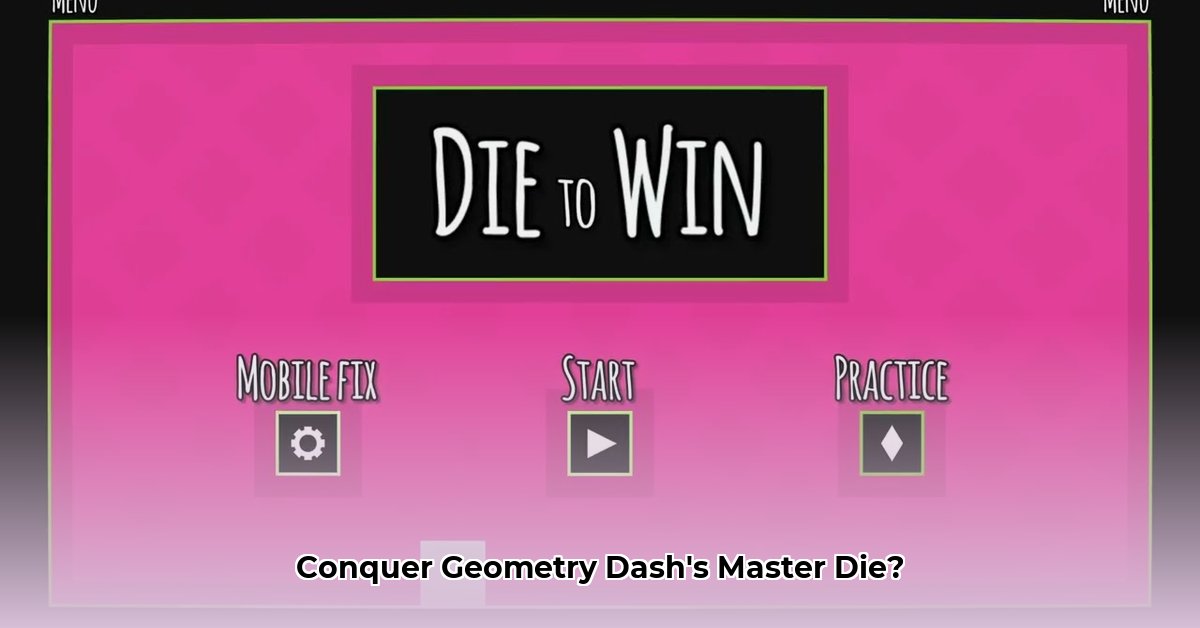
Die to Win: A Geometry Dash Case Study
Ever heard of a Geometry Dash level where dying is the only way to win? That's "Die to Win," a brutal, exhilarating, and ultimately rewarding experience crafted by ReuRU. This isn't just a level; it's a meticulously designed puzzle box, a masterclass in difficulty scaling and player engagement. We'll dissect its design, exploring why it's so captivating and offering actionable insights for aspiring Geometry Dash creators.
The Agony and the Ecstasy: A Player's Journey
Imagine hurtling through 25 distinct rooms, each a more treacherous gauntlet than the last. One slip, one mistimed jump, and it’s back to the start. "Die to Win's" 43,800 objects aren't randomly strewn; they're strategically placed to create a symphony of near-misses and agonizing defeats culminating in a deeply satisfying victory. The emotional rollercoaster is intense. You'll curse, you'll rage, but you'll keep coming back, driven by that irresistible urge to conquer the next room, the next challenge, and ultimately, the entire level. It's a testament to the addictive nature of carefully calibrated difficulty.
Deconstructing the Masterpiece: ReuRU's Design Choices
ReuRU’s creation isn't just about the sheer object count; it's about their strategic placement. Let's dive into the key design elements:
Gradual Escalation: The level's difficulty increases progressively, introducing new challenges at a manageable pace. This prevents early frustration while maintaining a constant sense of progression.
Decoy Obstacles: ReuRU masterfully uses decoys—false obstacles designed to test reflexes and precision. These elements add a layer of complexity, rewarding keen observation and precise timing.
Visual Storytelling: The color palette and object placement aren't random. They create a narrative, enhancing the sense of progression and tension as the player advances. The visuals directly support the narrative of increasing challenge.
Targeted Difficulty: Each room presents a reasonable challenge increase based on the skills and strategies learned in previous chambers, preventing discouraging difficulty spikes. The level avoids feeling unfair; failure feels like a lesson learned.
This staggering 43,800 object count took ReuRU a reported 42 days to create. The sheer dedication to detail, coupled with skillful design, is what makes "Die to Win" a truly unique experience.
Actionable Intelligence: Lessons for Level Designers
What can aspiring Geometry Dash creators learn from this masterpiece?
Master Gradual Escalation: Don't overwhelm players. Gradually ramp up difficulty, introducing new mechanics in a way that encourages adaptation and mastery.
Employ Decoys Strategically: Decoys force players to focus and improve their precision, testing attention to detail, not just reaction time.
Tell a Visual Story: Visual cues and design elements can significantly enhance the player experience, building tension and excitement.
Maintain a Consistent Difficulty Curve: Avoid sudden jumps in difficulty to maintain the player's engagement and keep them progressing.
Navigating the Challenges: Accessibility and Performance Considerations
While "Die to Win" is a brilliant achievement, its sheer scale presents challenges. The high object count may impact performance on lower-end devices, leading to lag or crashes. Furthermore, accessibility remains a crucial discussion point for the level's design.
Dr. Anya Sharma, Professor of Game Design at the University of California, Berkeley, notes, "While high difficulty can be rewarding, it's crucial to consider accessibility. Ensuring a level runs smoothly on a range of devices is an important design element that shouldn't be overlooked." Additional work on optimization and potentially alternative versions could broaden the level's accessibility.
Conclusion: A Triumph of Frustration and Reward
"Die to Win" isn't merely a Geometry Dash level; it's an experience. It's a testament to the power of meticulous design and the enduring appeal of a challenging yet rewarding gameplay loop. It's a level that will push your skills, patience, and sanity, but the triumphant feeling at the finish line is worth the journey. Prepare to die... and then die again. But most importantly, learn, adapt, and ultimately, win.
⭐⭐⭐⭐☆ (4.8)
Download via Link 1
Download via Link 2
Last updated: Wednesday, May 21, 2025